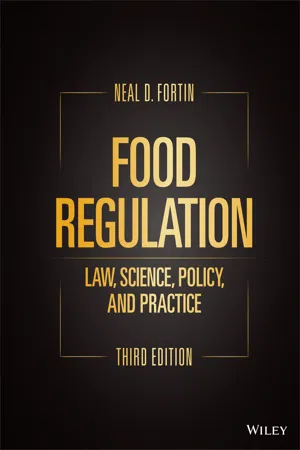
- English
- ePUB (mobile friendly)
- Available on iOS & Android
About this book
Provides both students and professionals with up-to-date coverage of US food regulatory law
Food Regulation: Law, Science, Policy, and Practice presents an in-depth yet accessible account of all key aspects of United States food regulation. Using a modified casebook format, this comprehensive textbook introduces readers to the case law and statutory scheme of food regulation, defines the inspection authority and enforcement tools of various regulatory agencies, discusses current and emerging public policy issues, and more. Readers explore a wide range of topics in food law, science, policy, and practice; which connect legal theory to practical application.
The third edition is fully updated to reflect significant changes in US food law, such as the regulations implementing the FDA Food Safety Modernization Act (FSMA) and the National Bioengineered Food Disclosure Standard. New case studies and discussion questions highlight important legal trends, policy debates, and application of current law. Offering thorough, highly practical coverage of food regulatory law, this authoritative volume:
- Features new and updated material on US food law, including recent regulations concerning novel food processing
- Covers requirements of food labeling, advertising and health claim guidelines, regulation of US food imports and exports, and international food law
- Discusses important topics such as food defense, regulation of biotechnology, ethical issues, product liability, food safety rules, and substantiation of health claims
- Includes a brief history of food regulation and an overview of US government agency organization and jurisdictions
- Contains problem exercises covering different aspects of food law designed to strengthen critical thinking
Food Regulation: Law, Science, Policy, and Practice, Third Edition, remains the ideal textbook for undergraduate and graduate courses in agriculture, food science, dietetics, law, and regulatory compliance management. It is also a must-have reference for food scientists, attorneys, researchers, quality assurance and regulatory specialists, and other industry professionals responsible for complying with US food regulation.
Frequently asked questions
- Essential is ideal for learners and professionals who enjoy exploring a wide range of subjects. Access the Essential Library with 800,000+ trusted titles and best-sellers across business, personal growth, and the humanities. Includes unlimited reading time and Standard Read Aloud voice.
- Complete: Perfect for advanced learners and researchers needing full, unrestricted access. Unlock 1.4M+ books across hundreds of subjects, including academic and specialized titles. The Complete Plan also includes advanced features like Premium Read Aloud and Research Assistant.
Please note we cannot support devices running on iOS 13 and Android 7 or earlier. Learn more about using the app.
Information
PART I
INTRODUCTORY CHAPTERS
1
INTRODUCTION TO FOOD REGULATION IN THE UNITED STATES
1.1 INTRODUCTION
1.2 A SHORT HISTORY OF FOOD REGULATION IN THE UNITED STATES
1.2.1 Why Do We Have Food Laws?
Whereas some evilly disposed persons, from motives of avarice and filthy lucre, have been induced to sell diseased, corrupted, contagious, or unwholesome provisions, to the great nuisance of public health and peace:Be it therefore enacted by the Senate and House of Representatives, in General Court assembled, and by the authority of the same, That if any person shall sell any such diseased, corrupted, contagious or unwholesome provisions, whether for meat or drink, knowing the same without making it known to the buyer, and being thereof convicted before the Justices of the General Sessions of the Peace, in the county where such offence shall be committed, or the Justices of the Supreme Judicial Court, he shall be punished by fine, imprisonment, standing in the pillory, and binding to the good behaviour, or one or more of these punishments, to be inflicted according to the degree and aggravation of the offence.
We face a new situation in history. Ingenuity, striking hands with cunning trickery, compounds a substance to counterfeit an article of food. It is made to look like something it is not; to taste and smell like something it is not; to sell like something it is not, and so deceive the purchaser.Congressional Record, 49 Congress I Session 1886.
1.2.2 The 1906 Pure Food and Drug Act
Table of contents
- COVER
- TABLE OF CONTENTS
- TITLE PAGE
- COPYRIGHT PAGE
- ABOUT THE AUTHOR
- FOREWORD
- PREFACE
- ACKNOWLEDGMENTS
- PART I: INTRODUCTORY CHAPTERS
- PART II: REGULATION OF LABELING, ADVERTISING, AND CLAIMS
- PART III: REGULATION OF THE COMPOSITION OF FOOD
- PART IV: SPECIALIZED FOOD REGULATION
- PART V: INSPECTION AND ENFORCEMENT
- PART VI: GENERAL CHAPTERS
- GLOSSARY OF ABBREVIATIONS AND SPECIALIZED TERMS
- TABLE OF CASES
- INDEX
- END USER LICENSE AGREEMENT